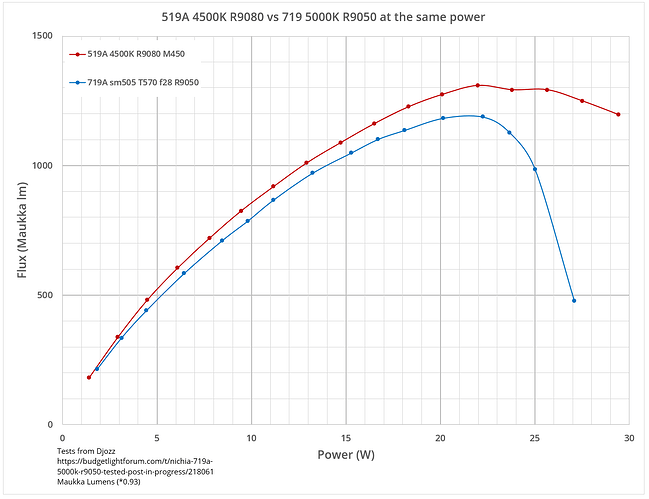I received a request from Simon from Convoyflashlights to test the new Nichia 719A. I have retired from testing stuff for a while, but I found this one interesting enough to do one more (no trend probably). I hope to get familiar with editing posts on the new website too, forgive me for not being fluent with the new editor.
The 719A is an interesting new led because it is a 6V domeless led without any visible signs of being multi-die, it seems one single die, I wonder what is the technology that Nichia uses here? (Edit: thefreeman has some more info in post#3, the trick is a “stacked die”)
Here it (the 5000K R9050 version) is at very low current to show the emitting surface:
Here is the page of the 719A on the Nichia site:
And a link to the datasheet:
The page tells you that it is a “super high luminance” led, and according to the datasheet, the max current is 1500 mA, pulse current 1800 mA (power-equivalent to 3000/3600 mA if it was a 3V led).
Here it is among some other domeless leds that I had around. The die size is closest to the XP-L Hi. I maybe should have added a sliced (dome removed) Samsung LH351D in the picture, the 719A die is smaller than that.
The leds are:
Luminus SFT-70 Luminus SFT-40 Yinding 5050
Cree XHP35 Hi Nichia 719A Osram CSLPM1
Cree XP-L Hi Osram CSLNM1
Tint measurements (pics see end of post)
I received 2x 5000K R9050 (one for output test destruction), 1x 3000K R9050, 1x 2700K R9050 from Simon, first I did some spectrum testing, for that I placed a smooth reflector on top of the leds and measured in the hotspot produced by the reflector. Btw, I have no phto of that, but the beam it produces is about perfect, no rainbow issues whatsoever.
Because I do not know yet how to resize spectrum pictures and place them next to each other, the (many) spectrum images are at the end of the post and edit them to size later. My general impression is that the claimed CRI is about correct up to 2A, but at 3A it goes significantly down (the output data shows indeed that the led is getting less happy at 3A). The 5000K version is a bit above the BBL (mind that hotspot measuring from a reflector usually increases the duv a lot from measuring the bare led), but the 3000K and 2700K stay very nicely near the BBL.
Output measurements
The voltage/output test was done like all my emitter tests except the really ancient ones, for links to my other led tests, see the djozz-test link when you click my avatar. I described the method in detail in my XP-L test, with two minor upgrades since that should not matter significantly for the results: I used my Integrating sphere no. II instead of no. I, and for the current I used a clamp meter, which appears to measure 0.1A lower than the power supply current-reading that I used for my earliest led tests.
Some further remarks about my led tests: 1) just one led was tested which I hope is representative for the whole batch, reflowed on a DTP copper board (XP-KDlight 20mm) that was clamped to a chunky cooled copper pillar with heatsink paste between, 2) I used my large version II integrating sphere with high quality luxmeter, 3) the output numbers and voltages were measured with the led close to ‘steady state’ for each current, so warmed up and settled, you should be able to get these numbers in a well heatsinked flashlight. Mind that these are output numbers of the bare led, in a flashlight there will be losses from light obstructions, lens and optic, 4) output is in ‘djozz-lumen’ defined as 1/550 of the output of my Sunwayman D40A on high setting, which I hope is close to the real lumen, but at least is consistent over all my emitter tests done in integrating spheres. A few years ago I checked the djozz-lumen against lights measured by maukka and the djozz-lumen seems 7% to 11% high (depending on spectrum) compared to maukka’s calibration.
Here are the results for the output test of the 5000K R9050 version of the 719A, sorry, not a nice computer graph because my ancient Mac does not communicate with the world very well anymore, I may update this post sometime when I got that working again
The sharp decline after 3.5A seems to me a sudden failure of the led, including severe damage of the phosfor. Going back to 2A never restored the output (I got about half the output back).
The maximum output seems on par with the XP-L hi of a couple of years back, Texas_Ace found 1620 lumen at the time, if you take into account that this led is R9050, 1280 lumen max is about consistent with that.
Conclusion
For Nichia to make a domeless led with the approximate luminance of a Cree XP-L Hi is new and special, but the luminance may still be a bit underwhelming when reading their jubilant claim about the technology.
For me as a flashlight modder a 6V led is more complicated to use than a 3V led, but there are some very nice boost drivers nowadays if you want to stick to single cell (like me).
-------‐-------
Spectrometer readings
719A R9050 2700K, at 1A :



719A R9050 3000K, at 1A :



719A R9050 5000K, at 0.3A :



719A R9050 5000K, at 1A :



719A R9050 5000K, at 2A :



719A R9050 5000K, at 3A :














